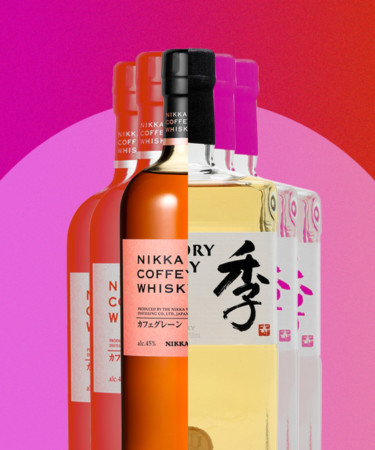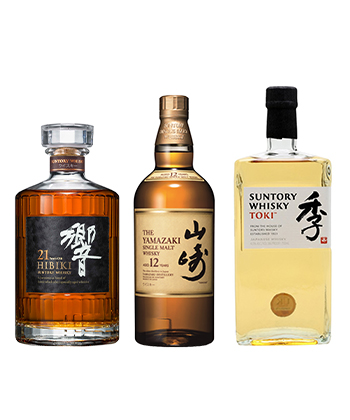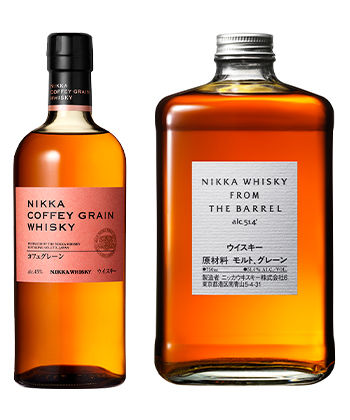With just a century of production under its belt, Japanese whisky is still a relatively new category. Following a series of awards that brought an international focus to the style, interest in the country’s whisky offerings has grown exponentially over the past few years.
As Japanese distilleries fight to keep up with the growing demand and a new set of regulatory guidelines, two companies, Nikka Whisky and Suntory Whisky, continue to dominate. And while many smaller craft distilleries have come on the market, Nikka and Suntory’s influence in Japan’s whisky industry is undisputed.
But how do these two formative Japanese whisky brands compare? Read on for the difference between Nikka and Suntory.
Origin
Nikka and Suntory’s histories are linked, originating from the entangled relationship between two pioneering men, the company’s respective founders — Masataka Taketsuru and Shinjiro Torii.
Torii, who honed his skills in blending and mixing Western-style liquors during a pharmaceutical apprenticeship, opened Yamazaki, Japan’s first whisky distillery, in 1923. But it was Taketsuru, a talented chemist and distiller with a mastery of Scotch production, who was hired by Torii to run the distillery. After a decade at Yamazaki, which ultimately became known under the name Suntory, Taketsuru branched out on his own and opened the Yoichi Distillery in 1934. In 1940, Taketsuru released his first whisky, named “Nikka,” under Dai Nippon Kaju, meaning the “great Japanese juice company,” a reference to the apple products he made prior to launching his whisky business. Taketsuru officially changed the company’s name to Nikka Whisky in 1952.
Production
From the beginning, Japanese whisky has been heavily influenced by Scotch whisky traditions, made with double- distilled malted barley (and other cereal grains), often sourced from Scotland, and sometimes peated, then aged in wood for a minimum of three years.
But Japanese whisky also has its own distinct characteristics: Whereas some Scotch may include blends from more than one distillery, a lack of collaboration among Japanese distilleries results in each retaining its own unique style. The Japanese also sometimes employ a special type of cask to age whisky made from mizunara oak.
To generalize, Japan’s whiskies are often described as being more delicate and less smoky than Scotch, but even these traits can vary. When it comes to Nikka and Suntory, both brands have a wide range of whisky expressions, and in past years have expanded their offerings to include gin and vodka.
Flavor
For VinePair’s 15 of the Best Bottles of Japanese Whisky, writer Jonah Flicker describes Suntory Toki as “bright and citrusy, if perhaps a bit thin.” Also from Suntory, Yamazaki 12, a gateway Japanese whisky, is aged in several different casks, including mizunara, and shows “notes of tropical fruit and dry spice on the palate.” The Hibiki 21, a rare gem of a bottle that commands a hefty price, receives high marks from Flicker for its “rich sherry notes and a touch of smoke.”
Flicker touts Nikka Coffey Grain as a “grain whiskey [that] will appeal to bourbon lovers,” while Nikka From the Barrel, a blend of more than 100 malt and grain whiskies, is just as smooth “as any single malt.”
Use in Cocktails
When using Japanese whisky in cocktails, a natural place for bartenders to begin is in the classic Highball, a drink that combines just two ingredients — whiskey and sparkling water — over ice. But the cocktail’s simplicity can be misleading. As Kat Odell for VinePair explains, the Japanese Highball can be “deceptively complex,” requiring bartenders to take every detail into consideration, from carbonation levels to the whisky’s proof.
For her Highball creations, Kelly Verardo, the brand bar manager at Osteria Morini, opts for Suntory Toki, praising its low-bodied profile and citrus flavors. When it comes to Nikka, Verardo is happy to sip the whisky on its own, but adds that when subbed in for the traditional rye, it makes “a nice touch on a Manhattan riff.”
Why the Pros Love Each
Verardo praises Nikka and Suntory “for their excellent quality,” noting that they “always make the ‘best-of’ lists.” For Verardo, the brands offer a wide range of products worthy of a deep dive: “Like with Scotch, it’s about experimentation and finding which one suits you best.”


